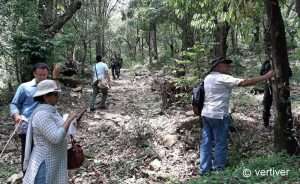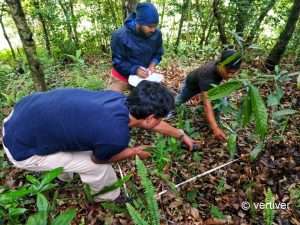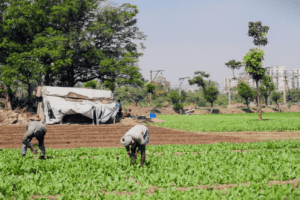Restoration and enhancement of natural ecosystems is critical for developing the resilience of forest and farming systems. Based on their work in this sector, Chhaya Bhanti and Saurinder Goswami highlight the importance of enhancing awareness, financing, capacity development, and monitoring towards natural resource management as a key priority for India.
CONTEXT
This year, the International Day of Forests holds special significance. We’re a year into a once-in-many-generations pandemic caused by a virus that crossed over to human populations through a combination of factors linked to forest and habitat loss. Warnings about the dire consequences of habitat loss — species loss, man-animal conflicts, increase in zoonotic diseases et al. — have been issued by ecologists for decades. Last year, scientists[1] urgently appealed for a halt to deforestation and wildlife trade, to ensure that wild animals that host pathogens dangerous to humans if crossed over, are not forced out of their natural habitats.
RECOVERING FROM COVID-19 IMPACT
The crippling economic fallout of COVID-19, has shown the vulnerability of a business-as-usual economic approach. Employment linked to central production systems has been severely challenged, and degraded natural ecosystems in rural areas have proven inadequate to sustain the increased pressure from reverse migration. Business-as-usual does not put a price on environmental or social externalities. Quantifying how much of the pandemic’s economic casualty is ultimately connected to the loss of habitat and ecosystems is still being studied. However, one thing is clear, healthy ecosystems are the only buffer we have to tackle the increased risks to humans and biodiversity, and the only insurance available to us for increasing resilience in the face of extreme events such as pandemics, which the climate data tells us, are projected to only increase.
No discussion about recovery and well-being is complete without a massive focus on the restoration and enhancement of natural ecosystems. In India more than a quarter of the population is sustained by forest ecosystems, while almost half of the population needs agriculture for sustenance. The provisioning and regulating services from natural ecosystems are essential to the economic, social and environmental prosperity of India’s rural and urban populations.
CONSERVING ECOSYSTEMS & PROECTING BIODIVERSITY
Through our work at IORA and Vertiver (Box 1) we’ve had the chance to work on multi-disciplinary projects on natural resource management, land restoration, forest conservation, sustainable agriculture along with climate change mitigation and adaptation across India through policy, technology, finance, behaviour change and communications approaches. Having spatially mapped over 10 million hectares of forests over 27 states of India since 2010 to study land use-land cover change, we see a pattern of degradation of forest stock, proliferation of invasive species, loss of water bodies, and forest fires across the country. We have applied these data insights to the design and implementation of many on-ground nature-based solutions that conserve ecosystems and protect biodiversity. These, simultaneously lead to many economic and social benefits and co-benefits such as livelihoods, improved health, increased resilience and climate change adaptation, among many others.
 Field Assessment at Manipur
Field Assessment at Manipur
In Sikkim, we have worked on Jurisdictional REDD+ as part of the USAID-MoEFCC Forest-PLUS programme to enable resources and capacity for improved forest management. We have also worked on creating a state-level GHG emissions reporting system in Sikkim. In Mizoram, we have worked on reducing forest vulnerability from Jhum Cultivation, and identified approaches that blend traditional knowledge on resource use and management with development of suitable farming machinery for upland systems. In Assam, we have proposed innovative technological and community-led approaches to manage forest land, and developed a framework for carbon neutral development. In Madhya Pradesh and Karnataka, we have worked with communities to reduce pressure on forests by implementing fuelwood reduction and value addition technologies and creation of FPOs to help communities derive more value from the sustainable harvesting of and sale of Non-Timber Forest Products (NTFPs). In Maharashtra, we have supported DFID on the development of decision support tools for selection of appropriate species for varying landscapes. In Kerala, we have proposed landscape management approaches to address both forestry and agriculture ecosystem management, and in Gujarat we have worked on climate change adaptation and mitigation with farmers through sustainable agriculture practices.
| Box 1: IORA and Vertiver IORA Ecological Solutions is an environmental advisory group that specializes in policy, finance and technology-based approaches for climate action and biodiversity conservation through nature-based solutions. (http://ioraecological.com/ ) Vertiver is a sustainability consultancy that works at the overlap of behaviour change, communications and knowledge dissemination to enable cross-sectoral implementation of nature-based solutions. (https://vertiver.com/ ) |
LESSONS FROM IMPLEMENTATION
These, and other projects, point to the need for enhancing awareness, financing, capacity building and monitoring towards natural resource management as a key priority for India.
Strategic Communication
Awareness requires strategic and well-planned communications that focus not on the problem but on the type of solutions that are required. One of the key issues in conservation work is that although practitioners share data that emphasizes the problem, solutions are not well-communicated, confusing policy makers and citizens alike. We have seen that multi-lingual, context- specific communications that balance technical data with engaging interactive content and dissemination (across digital or folk performances) require visual thinkers and domain experts working together to create a common roadmap that rallies communities, policy makers, and funders. Awareness is also connected to the knowledge and dissemination of new tools that enable Artificial Intelligence- (AI) led advisory for agriculture, remote Decision Support Systems for improved forest management, SMS and other low-tech interactive response tools for farmers, Apps and Digital Forums for peer-to-peer learning, and citizen science approaches to increase stakeholder participation in management processes.
Financing
Financing that supports natural ecosystem management mostly include government funding and foundation grants, but as the private sector begins work to mitigate risk to their supply chains from loss of ecosystems, private sector partnerships are also seen as vital to meeting the funding gap that exists. Funding from MGNREGA, which already allocates a small portion for employment through improvement in green cover, can be enhanced to reduce the gap between need and availability of resources for such work. Some approaches, such as green bonds, REDD+, Voluntary Carbon Markets and Green Tree Credits, are fast emerging to supplement public funding. Emerging block chain encrypted technologies which can tokenize trees and their benefits are avenues that our organizations are now starting to explore. Our work on biodiversity financing a few years ago, showed that companies have been able to assess the vulnerability of their supply chains to loss of ecosystems and biodiversity, and as a result they are pledging to improve biodiversity through direct and indirect investments. Examples include, ITC’s investment of over USD 42 million in forestry and biodiversity conservation in 2018-19.
Capacity Development
Capacity development is a massive need across all aspects of the natural resource conservation value chain in India. From a forest ranger who needs training on new tools to manage forest fires, to a farmer who needs new knowledge on transitioning to low-carbon agricultural practices, to a woman farmer whose knowledge on nutrition-centric crops and value addition needs enhancing, to officials who need to gain new skills for managing data, to communities who must be taught improved management of seed banks and harnessing other indigenous knowledge, to FPOs that can gain certification for sustainable produce, to knowledge management systems that provide on-demand resources, to mapping of overlaps between different departments, data and relevant linkages for improved decision making — there are countless needs for building the capacity of all sectors to enable an integrated approach to natural ecosystem management which can lead to improvement in soil and water quality and enhancement of ecosystem services. We are currently working with GIZ to build the capacity of groundnut farmers and extension workers in Gujarat, to help them build resilience under various climate scenarios.
 Ground Truthing at Sikkim
Ground Truthing at Sikkim
Monitoring
Finally, all investments in improving our natural ecosystems can only yield positive results if robust monitoring systems are in place to assess their ongoing impact. These include enabling communities to monitor their own ecosystems with simple technologies such as geo-tagging and picture uploads to more sophisticated spatial monitoring of land use change as an outcome of interventions. In addition, primary monitoring of related farm-based incomes, biodiversity, soil and water quality and market linkages is also required to create reinforcing cycles of information linked to iteration, and improvement of interventions if required. The monitoring must continue until the intended objective has been achieved. We are currently carrying out a monitoring of all state-level investments in major schemes such as CAMPA (Compensatory Afforestation Fund Management and Planning Authority) in Telangana and IGC (Increasing Green Cover) in Odisha.
SUPPORTING MITIGATION
As part of its work on climate change mitigation and adaptation, India under its Nationally Determined Contributions (NDC) Goal 5, aims to capture an additional 2.5 to 3 billion tonnes of carbon stock in its forests for climate change mitigation and adaptation. Our work with the Ministry of Environment, Forest and Climate Change (MoEFCC) on creating a roadmap for NDC Goal 5 revealed several challenges including inadequate nursery capacity. To support India’s ambitious goals for increasing green cover including through Trees Outside Forests (ToF) technology can play a catalytic role by connecting nursery capacity with landscape-aligned species plantation as well as by connecting financing with verified plantation, and ongoing monitoring of such investments. We are also currently serving as partners to the International Union for Conservation of Nature (IUCN) and MoEFCC, on India’s first Forest Landscape Restoration (FLR) assessment project across five Indian states to enhance natural ecosystems. FLR ensures that conversations on forestry, biodiversity and agriculture are happening under the same lens to address land degradation in a holistic approach.
END NOTE
Loss of biodiversity, including agro-biodiversity, is a critical issue that needs addressing for improving ecosystems. Some years ago, we supported an IUCN/ITC study on Sustainable Agriscapes in Bihar, which highlighted the importance of pollination, pest control, nutrient cycling and water services from forests to enable sustainable agriculture. This was a great example of a business taking a prescient approach and correlating agri-yields with forest ecosystems. Many such studies are needed to map the importance of vital agro-forestry ecosystems to improve the health of natural ecosystems.
Forest and agro biodiversity have direct links to developing resilience of forest and farming systems and communities. Agricultural communities with local seed banks are also important custodians for maintaining this biodiversity. Building their capacity, to make crop decisions that help them adapt to climate change, will be key to reducing climate vulnerability and creating sustainable food systems. Due to population pressures, yield per unit area of land will need to increase through crop intensification. Encroachment into forest lands that typically results from increasing agricultural production can also be addressed through this approach. Work on water use efficiency and crop management under the Transforming India’s Green Revolution by Research and Empowerment for Sustainable food Supplies (TIGR2ESS) project on sustainable agriculture, in which we serve as partners, show that diversified cropping patterns, climate resilient crops, and restoration of local water bodies are important tools for building resilience (https://tigr2ess.globalfood.cam.ac.uk/ ).
Forests and farms play a pivotal role in climate change mitigation and adaptation. The almost 22% of forest area in India accounts for 7.1 Billion tonnes of carbon stock and agriculture is responsible for 22% of GHG emissions. Agriculture in India is also responsible for almost 89% of all groundwater use because of the high resource use practices and demand patterns. In addition the deep root systems in forests help in soil formation and protection which can solve the declining fertility of adjoining agricultural lands. Forest and tree systems can also substantially avoid soil run-off into rivers – thereby addressing the twin problems of erosion and floods. Forests serve as water catchments and well-maintained watersheds can provide enough water supply for agriculture in the vicinity. They are also the most effective and efficient carbon sequestration technology available.
Putting nature-based solutions at the heart of economic recovery is vital to shifting away from the business-as-usual approaches that exacerbate climate risks. As we continue work on protecting biodiversity and habitats, and linking ecosystem conservation with climate change mitigation and adaptation in India, we invite collaborations that help mainstream the restoration and enhancement of our vital natural ecosystems.
Footnote
1. https://pubmed.ncbi.nlm.nih.gov/32703868/

Chhaya Bhanti is Founder and CEO, Vertiver Private Limited, and Co-Founder, IORA Ecological Solutions. (chhaya@vertiver.com).

Dr. Saurinder Goswami is Vice President, Forestry, IORA Ecological Solutions.





Thanks to AESA for introducing through this Blog, the commendable work done by IORA Ecological Solutions and Vertiver consultancy organisations, in protecting biodiversity and conserving ecosystems and their valuable field experiences in divergent geographies, in multiple stakeholder partnerships.